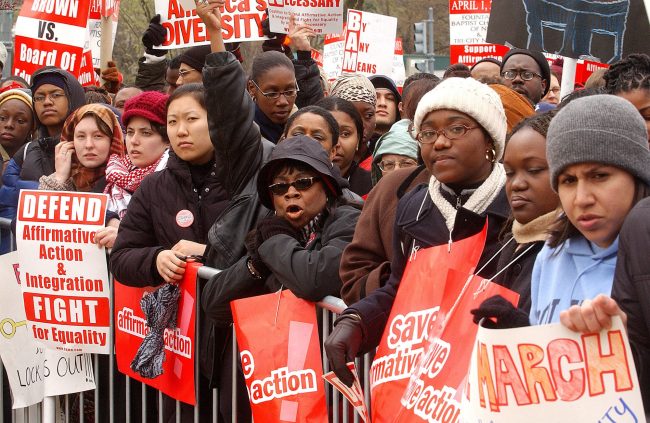
“Affirmative action was the government’s first and only program that attempted to combat institutional racism.”
Those words rang loud in my head, as my high school teacher taught my class the history of affirmative action and what the program is.
And as the years progressed, I started to see why my teacher had supported such a controversial program. Affirmative action is the only governmental program that had attempted to begin the deconstruction of institutionalized racial and sexist discrimination.
Given my political stance, it can be rightfully assumed that I would stand firmly for the passage of SCA 5, the now overturned proposal that would have brought back affirmative action in the California college admission process.
Despite this loss, I will still argue that affirmative action is fair and needed. Why? Because it attempts to even out the playing field for many underrepresented communities.
To understand my argument is to understand what affirmative action means and to grasp the politics of race and class in America.
Let’s start with understanding affirmative action. Affirmative action, as defined by the Merriam-Webster dictionary, is “the practice of improving the educational and job opportunities of members of groups that have not been treated fairly in the past because of their race, sex, etc.”
To be clear, affirmative action does not force companies and colleges to maintain a certain quota of disadvantaged groups (women, people of color and people with disabilities). Affirmative action does not guarantee equal results.
It is unconstitutional for any institution to employ a racial quota under the Equal Protection Clause. Also, state laws do not supersede the law of the land.
Affirmative action just factors in race as one of the many criterias that institutions use in the consideration of who to admit into colleges and employ.
And while some will cry that race being a criteria is unfair, consider the landmark case of Grutter v. Bollinger.
The case asked the question of whether or not it was fair for the University of Michigan Law School to use race as a factor in student admissions. The main question to be asked is if affirmative action violates the Equal Protection Clause of the Constitution (an argument commonly used by opponents of affirmative action).
And surprise, in a 5-4 decision, the Supreme Court found that it was not unconstitutional for the school to use race as one of its many admission criterias.
Supreme Court Justice Sandra Day O’Connor wrote: “in the context of its individualized inquiry into the possible diversity contributions of all applicants, the Law School’s race-conscious admissions program does not unduly harm non minority applicants.”
The key to affirmative action is that it brings the conversation of race and privilege into play. Why is it important that race should be a factor in our conversions? Because America is in no way a post-racial society.
Affirmative action continues to exist because if equal opportunity is a reality, then there would actually be an equal representation of groups facing discrimination in the workforce and educational institutions.
But the stark reality is that there is still a large disparity between the privileged and the disadvantaged.
Keeping on the subject of SCA 5, let’s focus this conversation on colleges in California. A previous Daily Sundial news article found that African-American college enrollment at CSUN has dropped in recent years.
The Office of Institutional Research found that in the Fall 2013 semester, African-Americans only make up 5.9 percent of the population, a decline since 2005. An NPR article also found that when affirmative action was first banned from California in 1996, African-American and Latina/o enrollment at UCLA quickly dropped. The declining rates at UCLA and CSUN cannot be a mere coincidence. These declines began when affirmative was taken out of the picture.
Of course, another false argument being perpetuated is that affirmative action lets in “less-qualified” African-American and Latina/o students over more qualified students(white and Asian-American students). But I will re-iterate that admitting someone solely based on their race is unconstitutional. Again, affirmative action only makes race one of many factors in the college admission process.
Plus, this way of thinking is highly racist, as it assumes that Black and Latina/o students are already unqualified. But if you believe in this stereotype, you should check your privilege and re-evaluate your life.
Now, the most recent Daily Sundial article about SCA 5 gave the Asian-American community a bad rep.
The article spun the same narrative that is being pushed out by mainstream media, that Asian-Americans were opposed to SCA 5 (divide and conquer much?). It’s true that SCA 5 did create a split in our community, but it’s not much of a divide.
In 2012, a national survey conducted by the National Asian American Survey asked Asian-American and Pacific Islanders where they stood on affirmative action.
The question was worded in two ways, yet the results yielded this: between 75-76 percent of Asian-Americans and 65-67 percent of Pacific Islanders support affirmative action. The opposition in the Asian-American & Pacific Islander (AAPI) community is quite low, as only 14-15 percent of Asian-Americans were opposed to the policy.
Major AAPI groups like Asian-Americans Advancing Justice-LA plus over 70 other AAPI groups have filed a brief to the Supreme Court in support of race conscious admissions.
Affirmative action is not perfect (nothing is), and still has problems. But for now, I’ll take what I can get. Many will oppose this article, whining that I should stop using the race card. Look, if racism didn’t exist in our society this article and affirmative action would not exist.
But since racism does exist, it is important that affirmative action is in place to keep the conversation of race going. We are humans and we are not colorblind.





